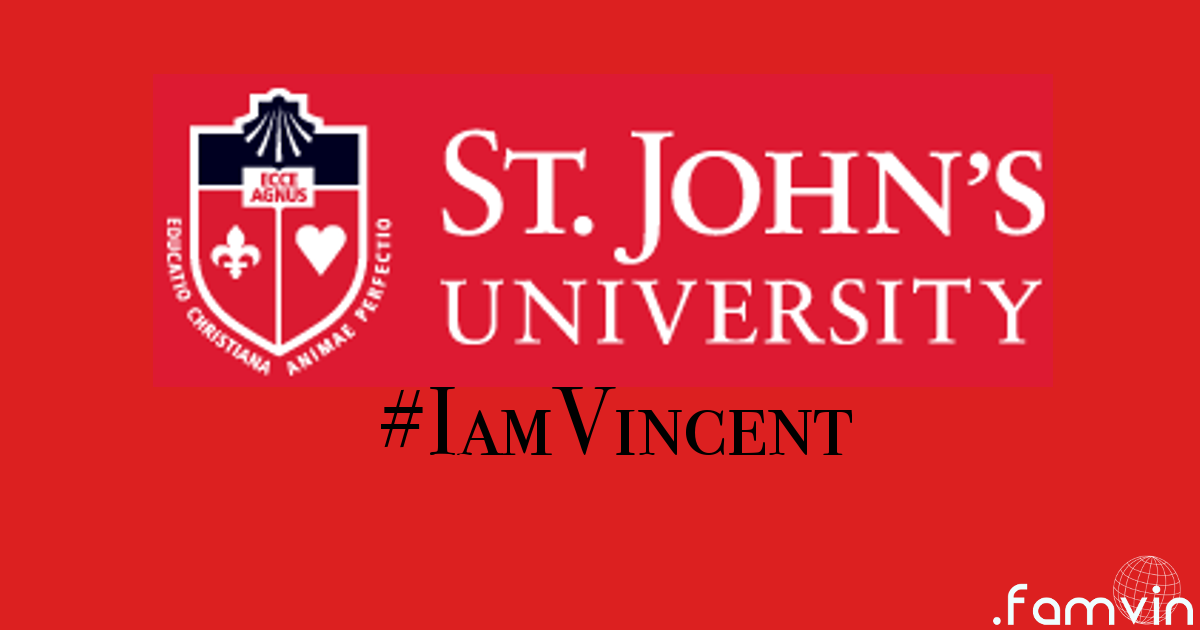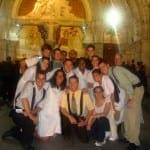 This is the first of a series of “#IamVincent” from St. John’s University. It’s time that we knew the stories and lives of Vincentians all over the globe.[Ed.]
This is the first of a series of “#IamVincent” from St. John’s University. It’s time that we knew the stories and lives of Vincentians all over the globe.[Ed.]
At the heart and center of the Queens campus of St. John’s University stands St. Thomas More Church. This holy ground is a place of prayer, worship, and community. In an institution of higher education, St. Thomas More Church is also a classroom. Before incoming and transfer students officially begin their St. John’s education, they participate in a two-day orientation, preparing them for their transition into the University.
The orientation leads students to St. Thomas More, for two presentations: one on the university’s Catholic and Vincentian mission and one inviting students to participate in Campus Ministry.
The presentation on mission occurs in the narthex, the entrance space of the Church. The round space is surrounded by two levels of large mosaic panels with tens of thousands of small pieces of colored glass portraying the Vincentian story.
The top mosaics begin with St. Vincent de Paul preaching in Folleville, France. We then see the encounter of St. Vincent and St. Louise de Marillac, and the Ladies of Charity and Daughters of Charity in service. As your eyes wander to the other side of the Church, you find members of the Congregation of the Mission landing in America from Italy and then the panels conclude with the evolution of St. John’s University and St. Vincent in heaven.
On the first level, one side of the narthex depicts the story of the Miraculous Medal and St. Catherine Laboure. The opposite side includes the Vincentian saints and martyrs.
Our students sit in this space, surrounded by the pastel blue and whites of the mosaics. While they are introduced to the richness of our Vincentian tradition, this is more than a history lesson. This is an invitation.
What Must Be Done?
It is my charge, and the charge of my colleagues in Campus Ministry, to connect the story of Vincent and the larger Vincentian family to the lives of our students at this critical point in their lives.
We begin by showing that we are all Vincent the man, and we are all called to be Vincent the saint. Vincent the man, like our students, wanted to be successful. Not just for himself, but for his family. “Do you not also seek the same things,” I ask the students. “Your college degree will bring you food in your stomach, money in your pockets, and the opportunity to live a life of happiness that includes the caring of loved ones.” The students nod in agreement. “What if God is asking for more from you,” I share before intrigued eyes. “What if God needs more from you.” I point them to Vincent at the ambo in Folleville, and share how he discovered his gifts and talents in his conversion moments. In 1617, Vincent delivered a sermon that would be the founding moment of his life’s work to answer the question posed by Madame Gondi of “What must be done?”
This is now the question that our students, as members of the Vincentian family, are charged to answer. The pathway to this answer begins with the identification of their gifts and talents, as Vincent discovered his. When Vincent started answering the question, “what must be done” with his gifts and talents, he transitioned from Vincent “the man,” to Vincent “the saint.” “What are your gifts and talents,” I ask the students. “How will you use them to serve God?”
“What must be done?”
To Know God
When I stand in the narthex, extending this Vincentian invitation, it comes from a place of love and a place of friendship with St. Vincent de Paul. Over 16 years ago, I was a nervous and excited freshmen student, being invited into the family by Campus ministry. I, too, went to the freshmen orientation and heard how St. John’s was here to help me grow in my faith. They were at first words, but soon, they became the compass for my discernment.
My relationship with Vincent began when I was in 7th grade. I chose Vincent as my Confirmation name, perhaps foreshadowing my future ministry. I look back and often wonder about that early attraction to the French priest who cared so greatly for the poor. At St. John’s, I learned more about Vincent through my leadership in the St. Vincent de Paul Society, membership in V.I.T.A.L. (Vincentian Initiative to Advanced Leadership), and participation in the second Vincentian Experience.
When my discernment brought me to my first professional experience in Campus Ministry, new doors opened. I was invited to lead service experiences both locally in the streets of Manhattan to week long experiences in Lourdes, New Orleans and Germantown. I was formed by the Vincentians, Daughters of Charity and fellow Campus Ministers who allowed the spirit of Vincent to shine through their actions and words.
Both in and out of the classroom, I was inspired as a student, alum and Campus Minister to follow in the footsteps of Vincent. As a member of the Vincentian Mission Institute, I literally walked in his footsteps throughout France, only motivating me to live and lead as he did so many years ago.
Perhaps the greatest challenge came two years ago in Rome, at the motherhouse of the Daughters of Charity. I led a pilgrimage to Paris and Rome for the Catholic Scholars, a group of Catholic leaders dedicated to growing in their faith to lift up their peers and as graduates, to live their faith in their work and relationships. Rev. John Maher, C.M., now the Vincentian Director for the Eastern Province, and Rev. Greg Gay, C.M. Superior General, invited us to a traditional Italian lunch during our stay. One of the Daughters came to the table and introduced herself to all of the students. When she came to me, she asked in Italian what I did at the University. Fr. Gay, searching for a translation of “Campus Minister,” described me in unfamiliar words in Italian. After she walked away, I asked him what he said. “There is no translation for Campus Minister,” he said. “ I said that you know God.”
I was humbled by such a description. What greater compliment could one give another? On the other hand, what greater challenge could there be?
When I stand in the narthex, my words do not come from a script but from the heart. My prayer for the students is that they come to know God while they call St. John’s home. In knowing God, that they too, like Vincent, may find God and serve God in the poor of this world. In return, I pray that each time I tell this story, and extend this invitation, that I too come closer to knowing God and allowing the words of Fr. Gay to echo true.
A Vincentian University
St. John’s University is charged to prepare students for excellence and the pursuit of wisdom which flows from free inquiry, religious values and human experience . In their academic discipline and core curriculum, we are preparing students to not only be excellent professionals with an ability to analyze and articulate clearly what is, but also to develop the ethical and aesthetic values to imagine and help what might be.[1]
We are not forming students to graduate to serve in one place of work. The trend is for students to hold between fifteen and twenty jobs in their lifetime.[2] Our students will have many jobs, and many opportunities to respond to the Vincentian question of “What must be done?” This question leads to a discovery that is rooted in faith and love. In their time at the University, they will serve those in need through the organized efforts of Campus Ministry, Faculty research and Academic Service Learning. They will discover God in their prayer and reflection. Students will gather around the altar in prayer and in the sacraments, and they will engage in sacred conversations with Campus Ministers, members of the Vincentians and Daughters of Charity, and with one another.
On these days before they take their first class, they are challenged to be saints. We invite the students, as new members of a larger Vincentian family, to change the world.
There are many criticisms of this generation of students, best known as Millennials. Often ridiculed as young adults who as children always received a trophy, they also achieved more community service hours than any other generation before. This generation has a deep desire to serve.[3] Perhaps the faith language is lacking for this generation and their commitment to institutional religion is minimal or even absent at their family level. We offer an invitation to come to know God as the spirit that lives within them and the spirit that lives within others. This is the same spirit that moved Vincent and Louise and the same spirit that made Blessed Frederic Ozanam, as a college student, put his faith into action. And this is the same spirit that will emerge through our students, who as graduates will be cloaked in red, prepared to be the Vincentian saints of the present.
The last depiction of the top panel of the mosaics portrays students on the Great Lawn of the Queens campus, in front of St. Augustine Hall. To the right is St. Vincent de Paul. We invite our students to see themselves as a part of this great mission and for their college experience to be an answer to the needs of the world. As I conclude my time with the students, I once again offer our care, prayers and support. I then close with these words: “You are now a member of the Vincentian family. Discover your God-given talents, use them to serve those in need. Use your privilege and your education to help those who will never walk on a college campus. This is what St. John’s asks of you. It is what the world needs. Welcome to St. John’s University. Welcome to the Vincentian family.
What must be done?”
[1] Mission Statement, St. John’s University http://www.stjohns.edu/about/our-mission
[2] http://futureworkplace.com/wp-content/uploads/MultipleGenAtWork_infographic.pdf
[3] http://ndn.org/blog/2009/08/millennials-lead-nation-service-our-country

James R. Walters, Ed.D., is the Director of the Catholic Scholars program and Residence Ministry at St. John’s University. Walters is a four-time alum of St. John’s, and in 2007, met his wife, Suzie, for the first time in St. Thomas More Church. They were later married there in 2010.








0 Comments